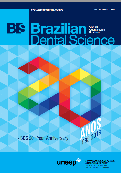Influence of testing parameters on the load-bearing capacity of prosthetic materials used for fixed dental prosthesis: A systematic review and meta-analysis
DOI:
https://doi.org/10.14295/bds.2018.v21i4.1652Abstract
The aim of this study was to systematically review the literature to assess static fracture strength tests applied for FDPs and analyze the impact of periodontal ligament (PDL) simulation on the fracture strength. Original scientific papers published in MEDLINE (PubMed) database between 01/01/1981 and 01/06/2010 were included in this systematic review. Data were analyzed considering the test method (static loading), material type (metal-ceramic-MC, oxide all-ceramic-AC, fiber reinforced composite resin-FRC, composite resin-C), PDL (without or with) and restoration type (single crowns, 3-unit, 4-unit, inlay-retained and cantilever FDPs). The selection process resulted in the 72 studies. In total, 377 subgroups revealed results from static load-bearing capacity of different materials. Fourteen metal-ceramic, 190 AC, 121 FRC, 45 C resin groups were identified as subgroups. Slightly decreased results were observed with the presence of PDL for single crowns (without PDL=1117±215 N; with PDL=876±69 N), 3-unit FDPs (without PDL=791±116 N; with PDL=675±91 N) made of AC, 3-unit FDP (without PDL=1244±270 N; with PDL=930±76 N) and inlay-retained FDP (without PDL=848±104 N; with PDL=820±91 N) made of FRC and 4-unit FDPs (without PDL=548±26 N; with PDL=393±67 N) made of C. Overall, for single crowns, fracture strength of FRC was higher than that of AC and MC; for 3-unit FDPs FRC=C>AC=MC; for 4-unit FDPs AC>FRC>C and for inlay-retained FDPs, FRC=AC. An inclination for decreased static fracture strength could be observed with the simulation of PDL but due to insufficient data this could not be generalized for all materials used for FDPs.
Downloads
Downloads
Published
How to Cite
Issue
Section
License
Brazilian Dental Science uses the Creative Commons (CC-BY 4.0) license, thus preserving the integrity of articles in an open access environment. The journal allows the author to retain publishing rights without restrictions.
=================




























